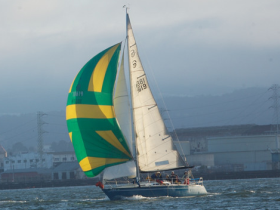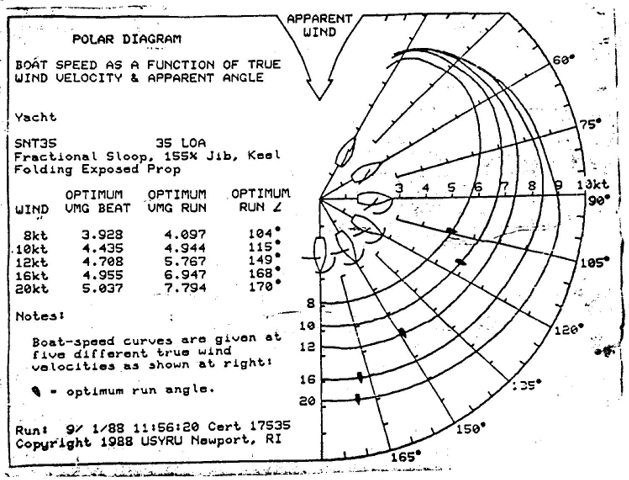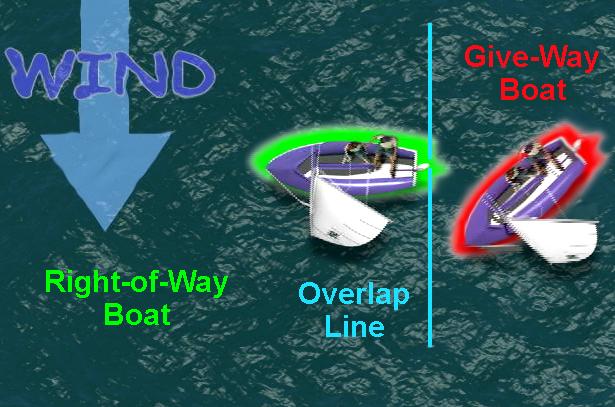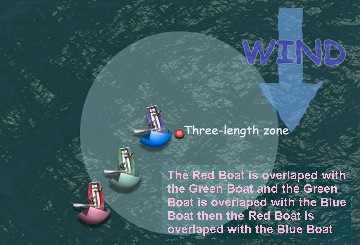
 Home
Home
»
Carpool
»
Contact Info
»
Debrief
»
Fleet Info
»
Links
»
Logistics
»
Marks & Courses
»
Photos & Videos
»
Procedures
»
Results
»
Rules
»
Sitemap
»
|
Procedures
Tactician
The tactician acts as an advisor to the skipper. The primary responsibilities of the tactician are to:
- gather information from various sources (e.g., by looking at the wind and current out on the course, and talking to the spotters and other crew members),
- analyze the gathered information, and
- provide recommendations to the skipper about where to sail and what strategy to pursue with respect to other boats.
The tactician may also help out with various duties on deck as necessary.
If you're not familiar with some of the terms or concepts on this page, look them up in the Glossary and review the Sailing Basics page.
Strategy
- Sail clean and fast.
- When in doubt, stay out: If we're not sure of the rules, it's better not to mix it up with other boats.
- Keep clear of boats that have the right-of-way. Right-of-way boats must be able to turn in either direction at any time. We can foul a right-of-way boat by simply being too close.
- Even if we have the right-of-way, our best bet may be to avoid mixing it up with other boats:
- Stay clear of other boats and don't lose speed/momentum. It takes a long time to get an 8,000 lb. boat back up to speed.
- Focus on what's going on with our boat instead of who has the right of way. Focusing on the rules distracts us from maximizing our speed and can be very counter-productive.
- Be aware of the layline to marks, and know what the current is doing.
- Be conservative: stay under the layline (taking the current into account), so that leeward boats can't push us up over the layline.
- Be aware of the boats around us, and how they established an overlap.
- Leeward boats that "broke the glass" can only push us up until their proper course. Same goes for us, if we're the leeward boat and we established an overlap by breaking the glass.
- Look ahead and make decisions early – in skiing terms, "think 4 moguls ahead."
- The rudder acts like a big brake – it's better to change our course by 1 degree (less brake) early, than to change our course by 40 degrees (more brake) after we've gotten into a right-of-way situation.
- Close the door on other boats early – let our boat do the talking by taking away options other boats may have early-on.
- Err conservatively when sailing downwind:
- Boats need a wider berth, since they don't have a brake when heading downwind.
- Penalties must be taken immediately, and a 720° penalty is huge downwind: We have to drop our spinnaker, hoist the jib, and take two turns before we can go on with the race.
- Sailing around marks:
- Think of the zone around marks as being 4 or 5 lengths rather than 3 lengths. People (including professional sailors) usually underestimate distances when they are trying to determine when they cross into the 3-boat-length zone around marks.
- Give boats behind us a no-overlap wave (run your hand parallel to our transom) if you don't think they're overlapped when we enter the 3-boat-length zone. This serves as a clear signal to them that we think we're clear ahead and that we have mark-room.
Tasks
- At the start: Punch in SC1 or the race committee boat on the GPS, and call out the ETE to Rod. This helps him gauge how far out to sail from the start line and when to turn back toward the start line.
Speed Polar
The speed polar diagram for the Santana 35 is shown below. Note that the calculations are for a 155 jib, which we do not have.

Rules
Friday Night Races at South Beach Yacht Club are governed by:
- SBYC's Sailing Instructions (includes list of courses, and rules on starts, recalls, time limits, use of corrected times, and throw-outs; will be published by 4/21/10)
- the Racing Rules of Sailing, 2009-2012 (pdf, 157 pages)
For additional information on the Friday Night Series, see also additional information from SBYC (Notice of Race, Official Notice Board, etc.).
Executive summary:
- Port-starboard rule: a boat on port tack has to keep clear of a boat on starboard tack.
- Overtaking boat rule: if boats are on the same tack without an overlap, the overtaking boat must
keep clear.
- Windward-leeward rule: if boats are on the same tack with an overlap, the windward boat must keep clear of the leeward boat.
- Quick way to tell if your boat is windward or leeward: If your boom is on the same side as the other boat, you are the windward boat.
- If the overlap was established by "breaking the glass" (the leeward boat crossed the overlap line with its bow within 2 boat lengths of the windward boat), the leeward boat can only head up to its proper course.
- If the overlap was established any other way, the leeward boat can head up all the way to head-to-wind.
- Start line:
- There is no rule against "barging" – barging is just an application of the windward-leeward rule.
- There is no proper course – leeward boats can always sail head-to-wind.
- Weather mark:
- For boats on different tacks, the port-starboard rule applies (there is no zone).
- For boats on the same tack, rights are fixed when the lead boat crosses a 3-boat-length zone around the mark (imagine that a snapshot is taken when the lead boat crosses into the circle):
- If there is no overlap when the lead boat enters the zone, the lead boat is clear ahead and can take the mark however is best for that boat.
- If there is an overlap when the lead boat enters the zone, the inside boat has mark-room (it must be given enough room to go around the mark in a seamanlike manner).
- Leeward mark:
- Rights are fixed when the lead boat crosses a 3-boat-length zone around the mark (imagine that a snapshot is taken when the lead boat crosses into the circle):
- If there is no overlap when the lead boat enters the zone, the lead boat is clear ahead and can take the mark however is best for that boat.
- If there is an overlap when the lead boat enters the zone, the inside boat has mark-room.
- For leeward marks, boats are deemed overlapped regardless of what tack they are on. That means that a boat on port tack can have right-of-way over a boat on starboard tack, if the boat on port tack is the inside boat and there is an overlap when the boats enter the zone. (For weather marks, a boat on starboard tack always has right-of-way over a boat on port tack – boats are deemed overlapped only if they are on the same tack.)
- Reaching marks are treated like leeward marks for purposes of the rules.
Longer, illustrated summary:
- A starboard tack boat has right-of-way (ROW) over a port tack boat:

- If two boats are on the same tack and there is no overlap, the boat that is clear ahead has ROW (the overtaking boat must keep clear):

- Two boats are overlapped if the aft boat crosses an imaginary line that runs through the aft-most point of the forward boat (the imaginary line is perpendicular to the forward boat).
- When boats are not overlapped, the forward boat is called clear ahead, and the aft boat is called clear astern.
- If two boats are on the same tack and there is an overlap, the leeward boat has ROW over the windward boat:

- Example: Two boats are on the same tack sailing to weather, and there is no overlap between them. In this situation, the boat that is clear ahead has ROW. If the boat that is clear astern catches up and establishes an overlap with the boat ahead, that boat then becomes the leeward boat and acquires ROW.
- Before the start line: the leeward boat can force the windward boat to head up, all the way until the leeward boat is sailing head-to-wind.
- After the start line: how far up the leeward boat can force the windward boat depends on how the overlap was established:
- If the leeward boat established an overlap by "breaking the glass" (its bow crossed the overlap line within 2 boat lengths of the windward boat), the leeward boat cannot sail further up than its proper course.
- If the leeward boat established an overlap any other way, it can sail up all the way to head-to-wind.
- A proper course is basically the expected heading a boat would sail on if the other boat was not there.
- Sailing around marks & obstructions:
- Rights are determined based on whether or not there is an overlap at the time that the lead boat enters a 3-boat-length zone around the mark.
- If there is no overlap when the lead boat enters the zone: the boat that is clear ahead has ROW and can go around the mark however is best for that boat.
- If there is an overlap when the lead boat enters the zone: the inside boat has ROW (called mark-room). Outside boats must give the inside boat room to go around the mark in a seamanlike manner.
- Rights are fixed when the lead boat enters the three-length zone, and do not change after that. The boat that has ROW at the time the lead boat crosses the three-length zone keeps ROW until it rounds the mark.
- Example: If a boat is clear astern when it enters the three-length zone (ie, there is no overlap), it must keep clear of the boat ahead, even if it overlaps the boat ahead and becomes the inside boat within the zone.
- Overlaps are established separately for every pair of boats, at the time that the boat in the pair that is closer to the mark enters the three-length zone (ie, when it is within 3 hull lengths of the mark).
- Overlaps apply transitively: If A overlaps B and B overlaps C, A overlaps C.

- If it's not clear whether or not there is an overlap, boats must use the last clear status quo.
- Example: If two boats were clearly overlapped half a mile back, and then it became unclear whether the boats were overlapped, and it remained unclear when the lead boat entered the zone, the boats are deemed to have had an overlap at the zone, because that was the last clear status quo.
- The inside/outside rule applies to leeward marks and reaching marks. The rule does not apply to boats on opposite tacks heading to a weather mark.
- When heading to a weather mark, a boat on starboard tack has ROW over a boat on port tack, even if the boat on port tack is inside and overlaps.
- Another way of saying this is that going upwind, boats are considered overlapped only if they are on the same tack. If boats are on different tacks, the boat on starboard tack always has ROW. If boats are on the same tack and overlapped, the inside boat has ROW.
- In contrast, when going downwind, boats are considered overlapped regardless of tack. Thus, a boat on port tack can have ROW over a boat on starboard tack, if the two boats are overlapped and the boat on port tack is the inside boat.
- Keeping clear:
- A give way boat (burdened boat) must give a boat with ROW the opportunity to do whatever it wants, whenever it wants.
- In particular, the ROW boat must be able to turn in either direction at any time.
- A burdened boat can foul a ROW boat just by being too close to the ROW boat.
- A boat must avoid collisions even if it has the ROW.
- When in doubt, stay out: If you're not sure of the rules, it's better not to mix it up.
- When a boat with ROW turns, it must give other boats a chance to keep clear.
- If your boat is the leeward boat, it's ok to yell "up! up! going up!" to a windward boat.
- If your boat is on starboard tack, it's ok to yell "starboard" to a boat on port tack.
- Penalties:
- If a boat hits a mark, it must execute one 360° turn.
- For other violations, the boat must execute two 360° turns.
- Penalties must be taken as soon as possible.
- If a boat starts prematurely, it must go back behind the start line and start again.

See the links below for additional summaries and illustrations of the Rules:
|

 Home
Carpool
Contact Info
Debrief
Fleet Info
Links
Logistics
Marks & Courses
Photos & Videos
Procedures
Results
Rules
Sitemap
Home
Carpool
Contact Info
Debrief
Fleet Info
Links
Logistics
Marks & Courses
Photos & Videos
Procedures
Results
Rules
Sitemap

